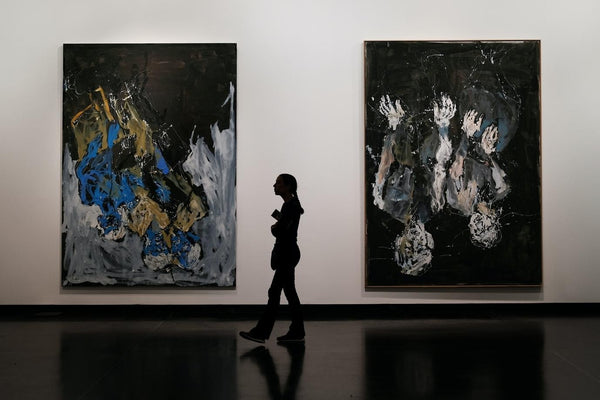Understanding the Nature of Abstract Art 📰

The Nature of Abstract Art
Meyer Schapiro was an art historian known for implementing art methodologies using interdisciplinary approaches. He explored historical periods within art along with the social, political, and physical factors involved in the construction of a specific piece.
Out of all his studies, Schapiro was known to study the nature of abstract art as well. There are two primary arguments that he puts forth:
- Changes in artistic style can be explored via the historical changes in social conditions, values, and ways of seeing a piece. This means that the history of society is an essential part of the art being created. It concentrates upon the fact that art, as autonomic as it may be, is strongly influenced by the social history and time period it was created in.
- Realism and Abstraction are not fully distinct from one another and a painting has a purely expressive value that extends beyond what is visible to the naked eye.
Understanding the Nature of Abstract Art
Abstract Expressionism is a unique form of art that many people have a hard time understanding or interpreting. Due to its complex structure and how it has evolved over the years, people find it more difficult to understand the art presented in front of them.
To fully understand the nature of a painting, there are some concepts and underpinnings you should also be aware of. For starters, there are two types of paintings: representational and abstract.
Representational Art
Representational painting and as stated by its name is mostly about specific illustrations that are recognizable to the naked eye. In most cases, a representational painting looks true to life and is only a mere copy of the realities around you.
When you look at any representational paintings, it is not difficult to understand what you are looking at. The physical objects, subjects, and colors used help you understand the canvas and the overall nature of the painting. However, not all representational paintings are as evident as they may seem. Some can be a mix of abstract and representation but are not too difficult to interpret.
The feelings and emotions involved in representational paintings are quite immediate. When you look at the canvas, you instantly figure out whether the painting clicks to you or not. Your mind is not made to wander off as much and the decision can be made with ease.
Abstract Art
Abstract paintings are quite the opposite of representational art forms. They comprise of designs, shapes, and colors that do not match physical objects in any way. Not only are the same objects more difficult to understand, but sometimes they may also carry dual meaning in the way they are painted.
Two types of abstract paintings are most commonly known: abstracted (or taken) from nature and pure abstract art. The former gives you an idea of what you are looking at and even though they are not as realistic as physical objects, they contain some elements that allow for an easy interpretation. Pure abstract art is even more complex. Such paintings do not reflect any sort of reality and you only see an amalgamation of colors, lines, patterns, and texture.
The feelings and emotions tied to an abstract form of art can be rather confusing for the human mind. You begin to question the painting, the painter’s intent, and the primary idea behind the masterpiece. Moreover, you also begin to analyze a subliminal message that may or may not exist in the painting.
Environment
In order to truly appreciate abstract forms of art, you need to look beyond the canvas that is in front of you. Since art is not timeless, the painting is created with a particular environment and niche in mind. If you begin to understand that environment, you’ll become submerged in the painting in its true essence. Due to this, it is equally important to study the artist's overall life as you understand their paintings and work of art.
History
History is also another factor that plays a significant role in art. It denotes the place and time a specific piece of art was created in and also showcases the ‘school’ of art that most popular during a given time period. Most artists worked with common cultures and along the same schools of thought within the art field. There were others, however, who did attempt to create new forms of art – all while common methodologies were adopted.
Towards the end of the 19th century, abstract art forms began to exist. Before this, artists employed solely representational forms of art. However, as the century wrapped towards the end, a revolutionary art movement in France introduced Impressionism – an attempt to introduce abstraction in realistic images.
Impressionism evolved to Neo-Impressionism and Post-Impressionism. Both the evolvements moved beyond one another and brought changes to color, texture, light, etc. used in the paintings. As the works of Post-Impressionists began to appear, art styles showcased new light and the abstract art world was introduced.
Painting Process
Another unique factor to understand abstract art is the painting process that most artists employ. After centuries, many attempted to use their unending imagination to not only showcase a masterpiece but also ways of fulfilling the end product.
Each painter experimented in their interaction with the painting, the canvas and their tools. Depth was so important now that the physical qualities of the painting such as the color, shape, and texture were concentrated upon.
An example of such a case can be Jackson Pollock’s ‘action painting.’ Originally called ‘Number 1, 1950,’ the painting was renamed ‘Lavender Mist’ at the suggestion of an art critic. The name ‘action painting’ was used to describe the processes Pollock went through in order to finalize the painting. He often used the floor for his large canvases and then drip, fill and spill paint all over.
Inner Psyche
Abstract art has the nature of challenging our inner psyche. As we immerse ourselves into a painting, we begin to manipulate our thoughts into finding out a deeper meaning behind the piece being observed.
Through this attempt, abstract art attempts to relate and engage us with our inner conscience. We begin to study and think beyond the physical realms that we are occasionally used to and try to interpret the painting through the eyes of the artist.
Within such thoughts, you also attempt to communicate with the artist. In most cases when you view a painting at an art gallery, the artist is never present. It is through the painting, description, and your thoughts where you attempt to understand the reason and motive behind the piece to begin with. To fully appreciate the piece of art and get in the shoes of the painter, you allow your mind to wander and be open to unexpected thoughts and emotions.
The partnership created between the observer and the painter is done mostly through the abstraction present. Due to this, it makes us realize why this specific form of art is truly unique and extends beyond what is presented to you.

How to Interpret Abstract Art
Now that you are aware of the widespread nature of abstract art, it is also important to understand how you can interpret the art in the most correct way possible.
Recognition
One of the first and foremost steps is to understand whether a painting falls under the category of abstract art or not. Here, it is solely about your knowledge and interpretive skills. Often times, abstract art stands out in other forms of art because of its complex nature. If it does not realistic, it’s most probably abstract art.
One of the mistakes many people make, however, is that they are unable to create a distinction between a child’s work and abstract art. Surprisingly so, since children attempt to use various colors and shades for their own sorts of paintings, many parents claim their work as abstract. However, abstract art is not only about the painting, but also the process that was involved to create the painting. As mentioned above, once you are able to communicate with the artist's intent and motive, you know the abstraction is working.
Knowledge
As mentioned earlier, interpreting abstract art is not about the painting only. One should have knowledge about the culture and history of the time period was created in. In most cases, such factors influence the work of art and it helps you to understand the artist better.
One way you can do this is by reading the small description box at art galleries. Sometimes they describe the painting, but other times they have brief information on the artist and their life. Reading that will help you understand the different elements used in the abstract painting and allowing your mind to wander, but also properly comprehend the piece presented in front of you.
Patience
Abstract art is not an immediate cycle of interpretation. It takes time for your mind to absorb the piece and fully understanding the various tones used. If you force yourself to find meaning, there is a high chance that you are wrong. Instead, let the meaning of the piece come naturally to you in order to fully make sense of the painting.
If the artist took a long time to create an abstract painting, there is a good chance that you should spend a long time trying to find its meaning. The art would be worthless if an observer only spent a few seconds to understand the weeks, or even months, of hard work put in by the artist.
Analyzing Abstract Art
There are three basic steps when it comes to analyzing abstract art:
- Describe: First, state the obvious. Observe the colors and objects that are present in the painting. This will help you dig deeper and create a better analysis rather than directly jumping into the hidden meaning of a piece. Some common questions you can ask yourself are: What do I see? Is any color repeated twice? What kind of color tones are used? Is the texture consistent throughout? Is the whole canvas used?
- Interpret: Second, you try to dig deeper and attempt to get into the shoes of the artist. Understand how the painting makes you feel and how the artist wanted you to feel. Moreover, read the title of the painting and see if that made any sense to you. In most cases, the title and description box help interpret some of the initial confusion you may have.
- Evaluate: This is a personal experience and how you felt by the painting. Some common questions you can ask yourself are: Was I moved by the painting? Did I like it? Did it disturb me, or make me happy? Did it speak to me? Not every painting speaks to everyone, and do not force an evaluation if you can’t find one.
Conclusion
Understanding the nature of abstract art is a complex task. However, once you begin to do that, you will find yourself easily immersed in any given abstract painting. It would help ease the interpretation process and allow you to understand what abstract art is essentially about.












